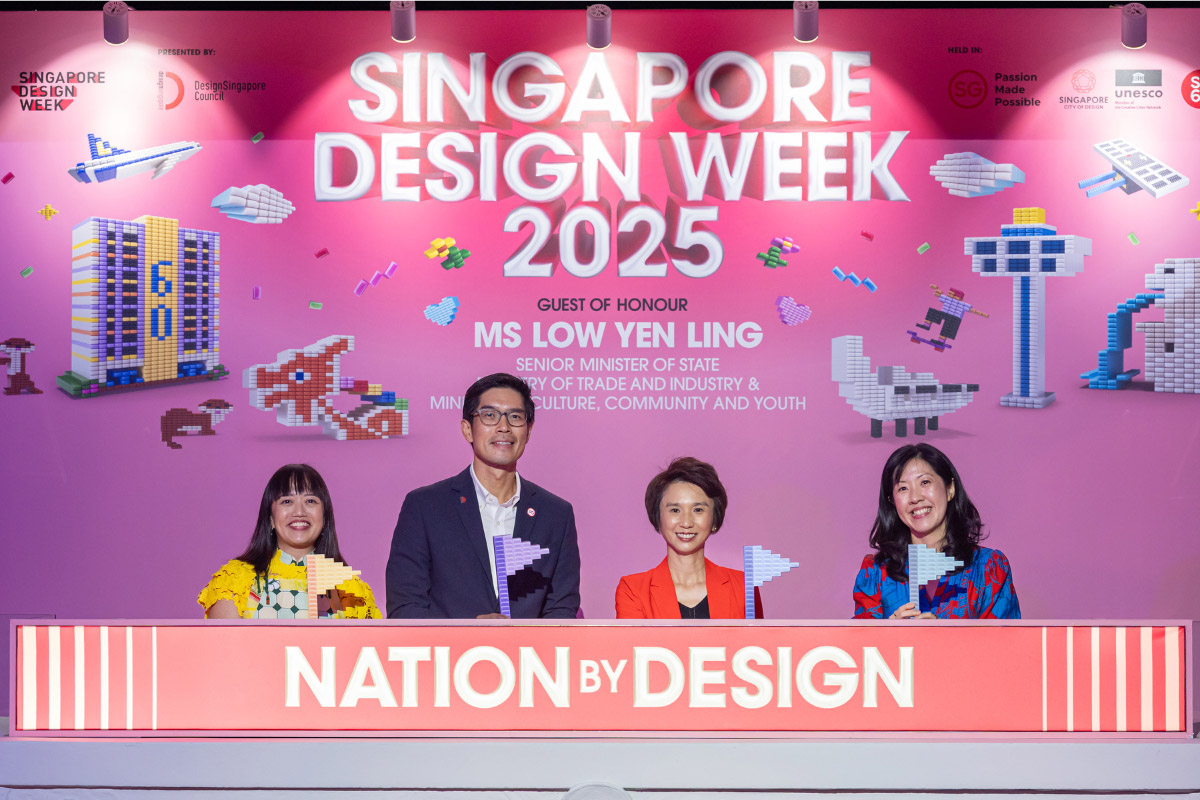Singapore’s design workforce to grow 25% Demand driven by non-design sectors
DesignSingapore Council’s manpower study reveals that over half of corporates surveyed are actively looking to add design headcount to their organisations in 2023
3 March 2023 – DesignSingapore Council (Dsg) today released the third National Design Industry and Manpower Study (NDIMS), which seeks to understand and establish manpower and skills gaps in the design sector.
With over 670[1] participants and panellists surveyed, the study conducted over two years from 2021 to 2022 looks to explore future opportunities for the design workforce and assess the current design freelancing landscape, deriving insights which will be used to formulate appropriate strategies and recommendations to develop policies, programmes, design education, and the larger design ecosystem.
The study defines the design workforce as encompassing the following:
- “Designpreneur”: Design business (or product) owners;
- Design Specialist: Design practitioners with creative capabilities in one or more design disciplines;
- Design Multiplier: Non-design professionals who advocate for design in their domains of work (e.g. sales, business management);
- Design Integrator: Practitioners capable of facilitating organisational innovation through design.
From now till 2030, the NDIMS found that the design workforce is expected to grow by 25% at a CAGR (compound annual growth rate) of 2.5%, with an additional 17,000 designers needed across Singapore’s economy in the next decade.
Rising demand and higher median income for designers
According to the study, 67% of Singapore’s design workforce worked in non-design sectors in 2021, which translates into two designers currently hired in the non-design sectors for every designer who is hired in the design sector.
Today, 3 of the 4 largest employers of designers are in non-design sectors, namely:
- Advanced Manufacturing and Trade (18%) sectors like the Aerospace industry and Food Manufacturing industry
- Urban Systems (15%) sectors like the Real Estate industry and Security industry
- Modern Services (14%) sectors like the Financial Services industry and ICT and Media industry
(Please see Annex B for the profiles of Andrew Chen and Dsg Scholar Cheong Yian Ling who are in key design roles in technology companies such as Meta and Thoughtworks.)
In the next decade, the study has further projected a stabilisation of the 2:1 ratio of designers working in non-design sectors versus those working in design sectors.
Firms are also searching for design talent who possess transdisciplinary skills, particularly in analytical thinking, business strategy, creativity and design communication. According to the Enterprise Survey conducted under the NDIMS, 51.2% of corporate respondents intend to actively add design headcount to their organisations in 2023.
“Designers provide a unique value to the finance and banking industry where excellence in customer-centred services and products is key. Within the Bank of Singapore, designers play critical roles across a range of functions, such as in product design, user experience, design research and content development. We are constantly on the lookout for designers who not only possess strong design sensibilities, but also transdisciplinary skills such as research capabilities, digital know-how and project management as an overall package,” says Chooake Wongwattanasilpa, Chief Experience Officer, Bank of Singapore and a board member of DesignSingapore Council.
In tandem with the rising demand for design talent, remuneration for designers in Singapore has corresponded accordingly. The median gross monthly income of designers was approximately S$6,000.00 in 2022 (excluding employer’s CPF contributions), around 50% more than the S$4,000.00 median income of full-time employed residents in 2021. This figure was derived from a companion NDIMS Compensation Study, which surveyed over 340 firms across junior roles to managerial positions in the design sector.
“It is encouraging to see that the NDIMS has validated the high demand for design talent in Singapore that we have observed, with a viable career trajectory that is supported by an attractive median salary. This demonstrates the value that design brings to organisations, and the exciting career opportunities for designers and design students. We hope it will encourage more designers and design practitioners in our economy,” says Eugene Chin, Acting Director, Talent Development, DesignSingapore Council.
To help design hirers find suitable talent and for designers to search for opportunities, Dsg is working towards the launch of a ‘Design Talent Marketplace’, a new career facilitation portal in the second half of 2023. This one-stop platform will connect designers and design graduates to organisations in design and non-design sectors that are eager to hire for design roles.
In addition, Dsg will continue to support and groom a design-empowered workforce through existing initiatives in partnership with other government agencies. This includes the Career Conversion Programmes (CCPs) by Workforce Singapore where mid-career individuals can undergo skills conversion and attend industry-recognised training to take on new job roles in growth areas, including UI/UX Design and Digital Product Design.
“Demand for design has expanded as businesses recognise its strategic value of creating user-friendly digital experiences. Businesses who could adopt a human-centric approach, combining how people experience, explore and interact in their design process had an edge over others. Against this backdrop, Workforce Singapore is pleased to be a strategic partner of DesignSingapore Council to grow the Design manpower and equip Singaporeans with the necessary competencies to take on emerging design disciplines such as Experience Design through the Career Conversion Programmes,” says Gillian Woo, Director, Creative and Professional Services Division, Workforce Singapore.
Positive outlook for freelance designers as income expected to increase
This third edition of the NDIMS was also expanded to include a study of the design freelancer workforce in Singapore. The total size of design freelancers currently stands at approximately 9,100 persons, comprising those who engage in freelancing formally and informally as of 2021. Of this, more than 50% of them (4,600) freelance formally with design work as their primary source of income, whereas 26% engage in freelancing gigs informally while holding full-time roles within the design workforce.
The study further noted that freelancers are motivated primarily by autonomy to choose rewarding and diverse work (71%) and attaining work-life balance or flexibility (62%). The outlook for freelancing is an optimistic one, with 68% of freelancers expecting their income to increase within the next two years with the normalisation of remote working in the post-pandemic workplace.
Global uncertainties and Singapore’s shifting economic priorities necessitate greater demand for design roles
The study notes designers will become more critical for future-proofing organisations in the face of global economic disruptions. The NDIMS presents a positive outlook for the design sector, as employers remain eager to hire and embed design roles in their organisations. According to industry sentiments within the study, the top five skills are analytical thinking, creativity, business strategy and design communication skills, and technical craft skills such as design creation and development.
“Industries are disrupted, automation is at our heels. Businesses are scared that everything is changing so fast. Here, design has a beautiful role to play – we can harness the disruptive power and shape it to create impact for businesses and societies. The skills highlighted in the NDIMS will be crucial for organisations looking to chart new ways forward in an uncertain world,” says Maish Nichani, Director of PebbleRoad, a Singapore-based design consultancy.
The report concludes that in response to macro-trends such as digital disruption, climate change and societal fractures, Singapore has responded with prioritisation towards strategic outcomes in Sustainable, Digital and Care economies. The opportunities for design to be high-value contributors to Singapore are in these areas:
- Sustainable future: Designers are responsible for a product’s life cycle and can shape decisions at a strategic level. Designers can design, measure and manage sustainable built environments, lead and enable circular economy transformation and incubate and grow nascent green industries.
- Digital future: Design has always been at the frontier of technological advancement and the workforce must evolve with technology to ensure it improves our quality of life. Designers can ascend the digital leadership ranks, deepen design and technological collaboration and humanise and drive the adoption of emerging technologies.
- Caring future: Designers can and must put their skills to shape a healthy post-pandemic recovery, particularly in high-touch industries such as education, healthcare and the social sector. They can revitalise and transform high-touch sectors, build an enduring and endearing city and co-design for social cohesion, connectedness and community.
“The latest NDIMS is a crucial guide towards understanding the current and future demands of the design workforce. Design skills are essential for Singapore to be an innovation driven economy as we grow in high tech areas like artificial intelligence and sustainable agri-tech, and high touch industries such as med-tech and digital financial services. Businesses will need more designers and design thinkers to help navigate change and give them the cutting edge,” says Dawn Lim, Executive Director of DesignSingapore Council.
To view the NDIMS summary report, please visit: bit.ly/NDIMS2023
Download the NDIMS media fact sheet here: bit.ly/NDIMS2023factsheet
About the DesignSingapore Council
DesignSingapore Council’s (Dsg) vision is for Singapore to be an innovation-driven economy and a loveable city through design by 2025. As the national agency that promotes design, our mission is to develop the design sector, help Singapore use design for innovation and growth, and make life better in this UNESCO Creative City of Design. The Dsg is a subsidiary of the Singapore Economic Development Board. For more information, please visit designsingapore.org.
[1] 670 participants and panellists include: 350 from compensation study, 230 from enterprise survey, 30 from freelancer survey, and 60 panelists across 12 focus group discussion.
Media contact
Serene Lim
Assistant Director
Brand, Marketing & Communications
DesignSingapore Council
Pearlyn Cheu
Senior Manager
Brand, Marketing & Communications
DesignSingapore Council






